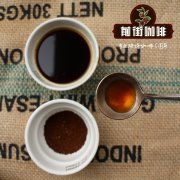Guatemala coffee taste Guatemala coffee shape

Professional coffee knowledge exchange more coffee bean information please follow the coffee workshop (Wechat official account cafe_style)
It is very rich in natural resources, which makes Guaguo coffee colorful.
The common tonality is elegant and lively, clean taste, layered, with green malic acid, jasmine, orange peel, green pepper, cocoa, some aftertaste will have a strong smoke smell.
With its diversified and rich regional taste and ever-changing charming aroma, it is surprising that almost half of them are high-quality beans (45% belong to the boutique grade). What kind of soil can always produce high quality?
Coffee in Guatemala grows in high-altitude cloud belts. Climatic conditions such as a large temperature difference in the morning and evening make the coffee not grow too fast, (because coffee grows too fast will make it softer.
The flavor is more insipid), coupled with the fertile volcanic soil, Guatemala coffee cultivation conditions are the most ideal in Central American countries, unlike the coffee beans produced in other Central American countries, the flavor is relatively clean and refreshing.
There are more changes in the style of Dimara coffee due to different elevations. Antigua, the capital, and Vivette Nanguo Gaotai in the northwest are the two major producing areas. These two major producing areas are full of people's impressions of Guatemalan coffee.
Digua Coffee has a better richness and subtle smoke flavor, while Vivette Nan Fruit Highland is characterized by delicate citrus acid.
Where's the coffee? In addition to their own qualifications, there is also a process of thousands of hammering chains.
Guatemala knew how to grow and drink coffee as early as 1747, and coffee became an important cash crop with the establishment of the Coffee cultivation and Promotion Committee in 1845. With the strong promotion of the government, coffee in 1880
Caffeine already accounts for 90% of Guatemala's total exports, and in order to achieve greater production, those in power have targeted indigenous land, forcing them to sell their land and move to more barren places. The second exploitation came from large enterprises.
Industry, during the Great Depression of the global economy in 1930, the powerful Jorge Ubico tried to drive down costs in order to stimulate the export market, and at the same time ceded more power and land to the large American joint fruit enterprises (UFC).
After Jorge Ubico stepped down, the incoming president, Arbenz, wanted to reclaim some of UFC's land and redistribute it to farmers, but in 1954 the Arbenz government was overthrown by a coup by the CIA's CIA.
Poverty, uneven distribution of land, famine, discrimination against indigenous peoples and other factors led to civil war (1960-1966), but these problems still exist today.
Important Notice :
前街咖啡 FrontStreet Coffee has moved to new addredd:
FrontStreet Coffee Address: 315,Donghua East Road,GuangZhou
Tel:020 38364473
- Prev

What is Vietnamese Coffee? How to drink Vietnamese coffee?
Professional coffee knowledge exchange More coffee bean information Please pay attention to coffee workshop (Weixin Official Accounts cafe_style) The world's second largest and Asia's largest coffee bean producer: Vietnam, in addition to exports, local people also love to drink. Coffee lovers are so high that you can't imagine that Ho Chi Minh City alone (population of about 8 million) has more than 6000 coffee shops with stores, which is more than Taiwan's.
- Next

SOE Coffee is suitable for soe Coffee beans soe Coffee how to drink soe Coffee and Handbrew
Professional coffee knowledge exchange more coffee bean information please follow the coffee workshop (Wechat official account cafe_style) order coffee in the cafe, have you been asked by the barista: do you want to buy our SOE? Was it confusing to hear the word SOE for the first time? As a matter of fact, SOE appeared abroad ten years ago, and now it has become very mature, and it has only been gradually developed in China in the past two years.
Related
- Beginners will see the "Coffee pull flower" guide!
- What is the difference between ice blog purified milk and ordinary milk coffee?
- Why is the Philippines the largest producer of crops in Liberia?
- For coffee extraction, should the fine powder be retained?
- How does extracted espresso fill pressed powder? How much strength does it take to press the powder?
- How to make jasmine cold extract coffee? Is the jasmine + latte good?
- Will this little toy really make the coffee taste better? How does Lily Drip affect coffee extraction?
- Will the action of slapping the filter cup also affect coffee extraction?
- What's the difference between powder-to-water ratio and powder-to-liquid ratio?
- What is the Ethiopian local species? What does it have to do with Heirloom native species?

